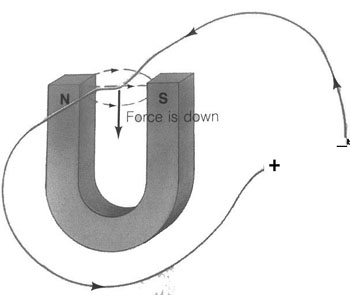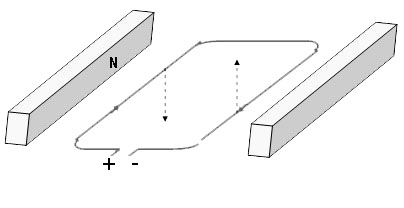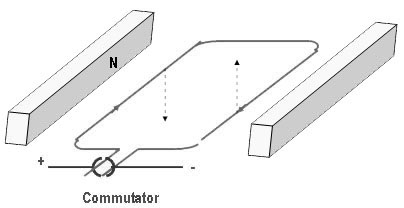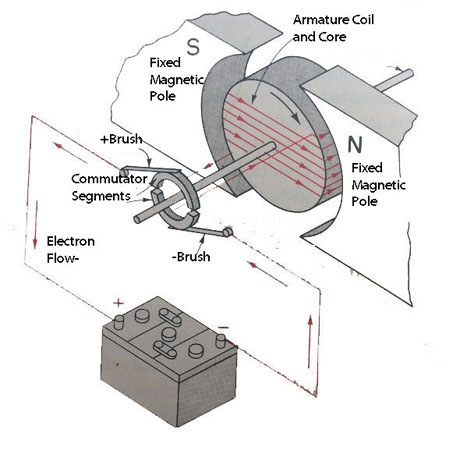How does a Motor Work?
Previously it was previously demonstrated that an electric current flowing through a wire gives rise to a magnetic field whose direction relies on the direction of the current.See magnetism from electricity.
It can also be demostrated that a magnetic force exerts a force on a wire carrying current. Pass a wire through a magnet as shown below and attach to a batter (Direct Cureent)y. A force in the down direction will force the wire to be pulled down.
A FORCE ACTS ON A WIRE IN A MAGNETIC FIELD

SIMPLE MOTOR LOOP SCHEMATIC
If we now insert a loop instead of a wire between a magnetic field (see image below), the left side o the loop will be pulled dowh and the right side will be pushed up. But as long as the direction of the current stays the same the loop will not rotate-- it will just line up with the magnetic field of the magnet. To get the loop to rotate we need to get the current to constantly switch direction. If an AC (alternating current is applied instead of DC the wire loop would rotate.

SIMPLE MOTOR LOOP SCHEMATIC WITH COMMUTATOR

There is a way however to get the loop to rotate using DC (Direct Current). By adding the "split" commutator the direction of the current in the coil will reverse every half turn and provides the conditions necessary to keep the coil in constant rotation.
DC ELECTRIC MOTOR

In the simple motor shown above the current in the rotating coil is reversed every half-turn by an automatic switching arrangement consisting of a split metal ring called a commutator. The rotating part of the motor is called the armature and consists of a coil with many turns of wire. The armature is mounted on an axis between two fixed magnetic poles. Each end of the armature is attached to one end of the commutator (see red arrows). Current enters the commutator via one brush connected to a battery. Current leaves the armature via the second brush which is in contact with the other half of the commutator. Since the brushes are fixed when the ommutator rotate , each brush is in contact with one half of the commutator during one half-turn and with the opposite half or the commutator during the second half-turn. As a result, the current in the armature reverses its direction every half turn and provides the condtions necessary to keep the armature rotating
Electricity, Magnetism and Electromagnetism
- Electricity and Magnetism Home
- Electric Charge
- Coulombs L;rent
- Electric Circuits
- Electric Power
- The Nature of Magnets
- Earth as a Magnet
- Magnetism in Action
- Magnetism from Electricity
- Electricity from Magnetism
- How do Transformers Work?
- Ohms Law Lab
- Magnetic Forces Lab
- Why Metals Conduct Electricity
- How does a Battery Work
- How does an Electric Motor Work
Science of Fluids
- Science of Fluids
- What are Fluids?
- What is Pressure?
- What is Hydrostatic Pressure?
- Surface Tension and Capillary Action
- Pascals Principle
- Archimedes Principle
- What is Viscosity?
- Bernouili's Principle